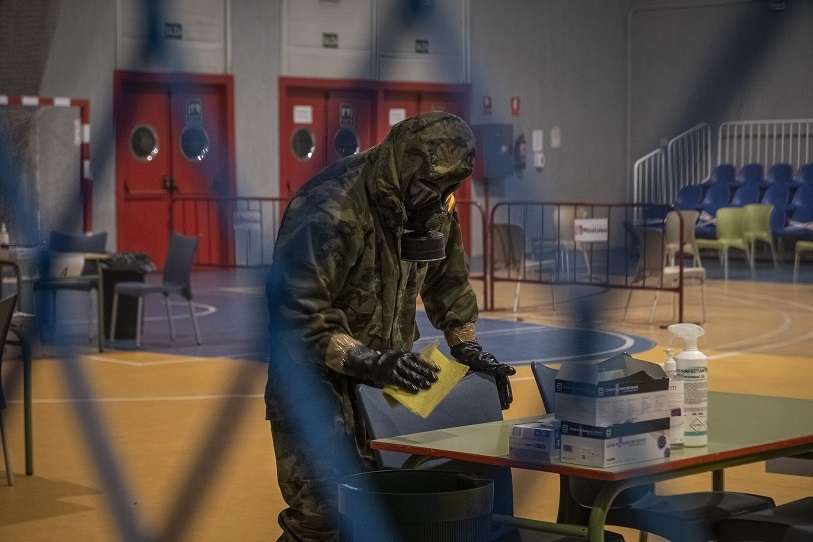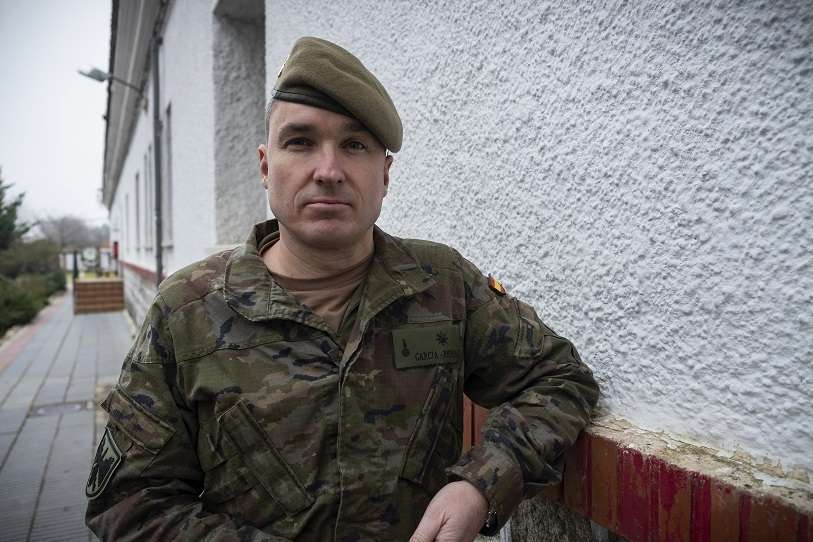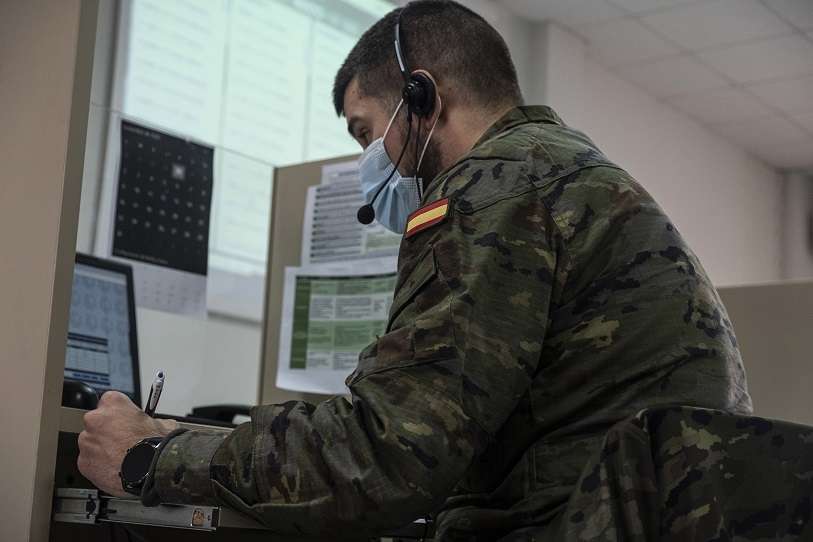El Ejército español sigue rastreando la COVID-19

he Spanish Armed Forces are back on the trail to combat COVID-19.
With the Baluarte Mission, the Spanish Army has given continuity to the interventions that began with Operation Balmis, at the beginning of the pandemic, to support civil society in the fight against the coronavirus. This mission officially began on 30 September 2020 and, unlike Balmis, has not been deactivated with the end of the second state of alert. As a result, the military continues to respond to requests from all the Autonomous Communities.
Although it is true that over the last twelve months decontaminations have decreased drastically, they are still being requested from some old people's homes, prisons, schools, hospitals or wards dedicated to mass testing. In addition, the army is taking charge of transporting vaccines and inoculating certain groups (as they did, for example, with the Spanish football team).
Under the Baluarte umbrella, logistical support has also been provided to hospitals, such as those in Gijón, Medina del Campo and Arnau in Valencia, where modular tents were installed for triage and even temporary visiting rooms. But the military trackers were undoubtedly the great novelty of this second military mission against COVID-19.

"One of the main efforts of the Baluarte Mission has been and continues to be the tracking of positive cases and close contacts, with 4.8 million telephone contacts having been made so far throughout Spain", confirmed the Retamares Operations Command (MOPS), where Operation Balmis was coordinated, and from where Baluarte is now being directed.
In the tracking centres, two types of calls are made: contact is made with new positive cases, to determine the close contacts they have had, and follow-up contacts are made. "On average, the military tracers talk to 8,000 new people every day who have been infected, plus another 7,000 cases of those who are being followed up," Lieutenant Commander Justo Javier Solana, one of the shift leaders of the Operations Command, explains to Atalayar.
At the moment, there are 1,172 military trackers working from the different call centres set up, but there were as many as 2,400 months ago. Even so, the demand from the different Autonomous Communities has not been as high as expected by the Ministry of Defence, which in the autumn of 2020 announced that they could mobilise 7,000 troops if requested by the Government Delegations. A figure that has fallen far short of reality.

One of the characteristics of these military trackers is the speed with which they are able to be operational. Proof of this is that during the month of June some call centres were closed in different parts of the country, and a few weeks later they were reactivated in record time.
"Generally, the trackers are personnel who are carrying out other tasks at their destination, but when the time comes, they can be transferred to a tracking centre from one day to the next," clarifies Lieutenant Commander Solana. "For each Autonomous Community there is a maximum number of trackers available, and it is the Ministry of Health, together with DIGENPOL, who approves the requests," he adds.
Castilla y León is the Autonomous Community that has requested the most military trackers. It is followed by Andalusia, which currently has 210 personnel, and Galicia with 90. The Balearic Islands requested another 90 a few weeks ago. Castilla-La Mancha, Valencia and Cantabria also have them.
In Madrid, where surveillance was deactivated on 21 June and reactivated on 22 July, there are currently 40 military trackers (20 from the Air Force in Torrejón and another 20 in the Army's Fuencarral Anti-aircraft Artillery Command). But there were as many as 150 troops, spread over five tracking centres (including El Goloso, the army's headquarters and the Getafe air barracks).

Commander Fernando García-Repáraz, head of the Epidemiological Surveillance Unit in Madrid, coordinated the five call centres from Fuencarral. "Each Autonomous Community has its own computer system; the trackers stationed in Madrid carry out their work through the applications managed by the Regional Ministry of Health. Through this platform, the Ministry assigns each day the different cases that have tested positive in a PCR, and from there the tracking begins," he explains to Atalayar, while the soldiers on the morning shift do not take off their phones.
Each tracer makes an average of ten calls a day. And they work from nine in the morning to nine at night, in two shifts. "Each call is different... a person who has spent most of the time at home, and with the same people, is not the same as someone who has attended social events and has been with many more people," continues García-Repáraz.
This is often directly related to age: the younger you are, the more contacts you have. And this is precisely one of the complications that have arisen when tracing in this fifth wave: those infected are mostly young people (the average is 29 years old), and their close contacts are multiplying exponentially.
These tracers also serve to ensure that positive cases have respected isolation. If when they make the call they find a positive case who is not keeping quarantine at home, they inform the Regional Ministry of Health so that they can take the appropriate measures. "But in general, people comply with quarantines and collaborate when you call them to do a trace", insists the head of the Epidemiological Surveillance Unit in Madrid.

Dealing directly with people is both the most satisfying and the most complicated. "There have been cases in which we have had to call the social services after talking to a person, because they told us they were alone or needed help... On one occasion, while the tracer was talking to a positive person, he had a respiratory failure crisis and had to call 112 and accompany him on the other end of the phone until he was evacuated to hospital... There are many stories," admits Commander García-Repáraz. "It's a very different job to what we do on a day-to-day basis as army combatants, but at the same time it's very rewarding for the tracker who carries it out.
One of these trackers is soldier Pablo Fernández Navarrete, a native of Linares and assigned to the radar section of the 71st Anti-aircraft Artillery Regiment. He was already assigned to the Gómez Ulla Hospital during Operation Balmis, but did not hesitate to volunteer for Baluarte, "like all my comrades", he adds. For him, the most valuable thing about both experiences has been knowing that they have a real impact on society, that they are useful and that they are helping the population in one way or another.
But he recognises that the work of a tracer sometimes costs more than it seems... "When you talk to older people, who in many cases are alone or have lost family members, and they tell you their story, it marks you," he says. These are experiences, she says, that make you empathise and mature. "Although we are bombarded in the news with the numbers of contagions, there are people from outside who believe that it is less serious than what they tell us... I would like them to see it from here," concludes Navarrete.

The military personnel who are tracking are volunteers. And the vast majority of them have already worked on Operation Balmis. Even so, they are being prepared for this new task with training that begins with an online phase, given by the Ministry of Defence; they then attend a series of conferences on the general aspects of the Baluarte Mission and the treatment of personal data, and other more specialised ones related to the contagion of the virus or how to identify close contact. The latter are given by experts from the Military Health Corps.
They are also taught how to deal with and empathise with the person on the other end of the phone. "These are very different profiles, and you have to know how to address each one," explains García-Repáraz. In all cases, they identify themselves as military trackers "because it conveys seriousness and credibility, and helps to build trust".
After a week of lectures and online training, they move on to "hands-on" training with the medical staff of the Community of Madrid (civilian trackers) who have been doing this work for more than a year. In addition, when they start at their post, during the first few days, they are supervised by UME personnel and veterans from the different tracing centres. "It's a kind of quality control, with which we certify that each tracker is prepared to do their job well".

The Military Emergency Unit (UME) was the first to carry out tracking within the army, planting the seed for what has become this new military operation. "They started tracking in mid-September 2020, before the official start of the Baluarte Mission; in fact, they were the ones who baptised it with the name Baluarte", clarifies Commander García-Repáraz.
According to the dictionary of the Real Academia de la Lengua, one of the meanings of the word Baluarte is "protection and defence". This is yet another example of the vocation behind this new army mission, which continues the work carried out in Balmis, the largest peacetime military deployment of the Spanish Armed Forces.
To point out a difference between Balmis and Baluarte, this second mission has not provided support to the State security forces. It has not been necessary to work with the police or the Guardia Civil. "But both missions share the same objectives: to provide support to the government and institutions to stop the pandemic and preserve the lives of citizens," stresses Justo Javier Solana, from the Operations Command.









